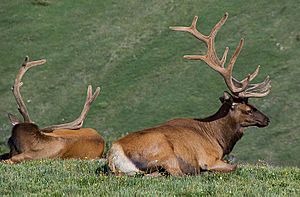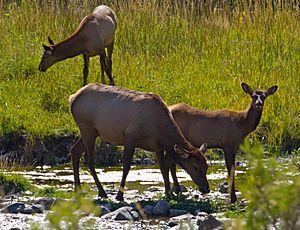Rocky Mountain elk facts for kids
Quick facts for kids Rocky Mountain elk |
|
|---|---|
 |
|
| Male Rocky Mountain elk | |
 |
|
| Female Rocky Mountain elk | |
| Scientific classification |
|
| Kingdom: | Animalia |
| Phylum: | Chordata |
| Class: | Mammalia |
| Order: | Artiodactyla |
| Family: | Cervidae |
| Subfamily: | Cervinae |
| Genus: | Cervus |
| Species: | |
| Subspecies: |
C. c. nelsoni
|
| Trinomial name | |
| Cervus canadensis nelsoni (Erxleben, 1777)
|
|
The Rocky Mountain elk (Cervus canadensis nelsoni) is a type of elk that lives in the Rocky Mountains and nearby areas of Western North America. These elk can live in many different places. You'll often find them in forests or near the edge of forests.
In the mountains, they usually stay high up during warmer months. When winter comes, they move to lower areas. Sometimes, they might even go into grasslands for a bit during the day, but they head back to the trees in the evening. Warmer weather can let elk stay in higher places longer into winter. This can also help them by keeping snow levels lower, which makes it harder for predators like wolves to hunt them. There are about one million of these wild elk today.
Bringing Elk Back Home
Long ago, the number of Rocky Mountain elk became very low. This was mostly because people built homes and roads in their natural areas. This destroyed the elk's habitats and the paths they used to travel.
To help them, elk were brought back to Colorado from Wyoming in 1913. A year later, 21 elk from Jackson Hole, Wyoming were moved to South Dakota's Wind Cave National Park to help grow the population there. In New Mexico, conservation efforts also helped elk numbers go from almost zero in the early 1900s to healthy groups by the 1930s.
Elk numbers in Nebraska also grew a lot in the 1970s and 1980s. This led to more hunting seasons to manage the population. The numbers kept growing through the 1990s and are still increasing today.
All Rocky Mountain elk in Washington came from elk herds in Yellowstone. These elk were brought there in the early 1900s. They have spread out, and some have been moved to other parts of the state. Some of these elk need extra food in winter because their natural winter homes have been lost.
In 1990, studies checked if wild elk could live again in some of their old homes in the eastern parts of the country. After this, healthy elk from Arizona, Kansas, New Mexico, North Dakota, Oregon, and Utah were used. These elk helped bring the subspecies back to areas where eastern elk used to live.
More recently, elk from Utah have been used to restart a population in Kentucky. In 2018, elk from Arizona were moved to West Virginia for the same reason. However, a parasite has unfortunately caused some of that herd to die.
You can also find these elk in Canada. They live in Alberta's Jasper and Banff National Parks. They are also in British Columbia's Kootenay and Yoho National Parks.
Health Concerns for Elk
Since 2010, Rocky Mountain elk herds have faced a serious illness called Chronic Wasting Disease (CWD). CWD affects the brain of infected elk. It has symptoms similar to mad-cow disease (BSE) in cattle.
Scientists are still studying CWD. There is no proof that CWD from elk can spread to humans. Researchers continue to learn about CWD and how it affects the environment and other animals. This disease is a big concern in places like Estes Park, Colorado and across Western North America. Leaders are looking for ways to solve these problems.
Images for kids



